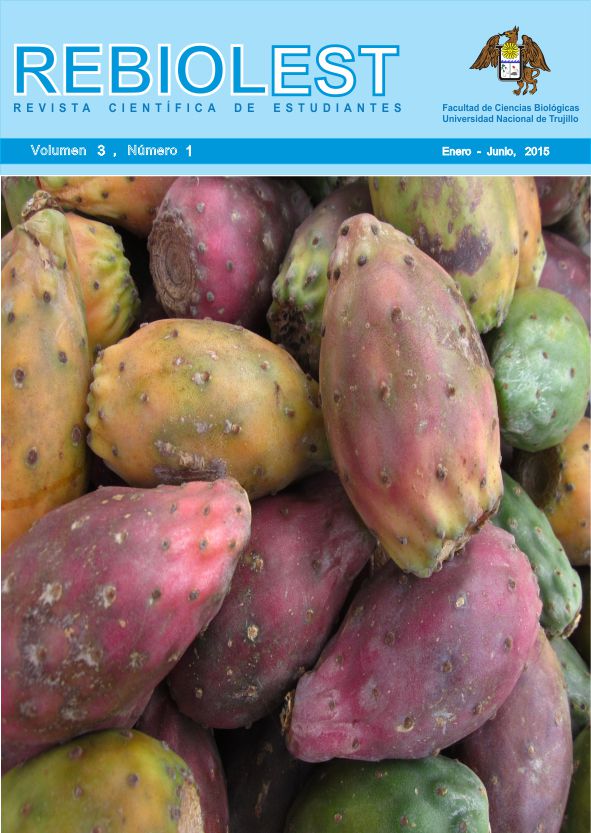Efecto del sobrenadante del cultivo de Lactobacillus sp. sobre el crecimiento de Staphylococcus aureus, Salmonella typhi y Salmonella enteritidis
Resumen
Se determinó el efecto del sobrenadante del cultivo de Lactobacillus sp. aislado a partir de heces de neonatos sobre el crecimiento de Staphylococcus aureus, Salmonella enteritidis y Salmonella typhi. Se recolectaron 15 muestras de heces de neonatos, de las cuales se aislaron e identificaron siete cultivos de Lactobacillus sp. La capacidad antagonista de los siete cultivos fue evaluada contra las bacterias patógenas mediante el método de difusión en agar. Se encontró que los cultivos de Lactobacillus sp. codificados como LMA-1, LMA-4, LMA-7, LMA-9 y LMA-13 presentan evidente capacidad antagonista, ya que inhibió todos los patógenos evaluados, mientras que el cultivo de S. aureus presento resistencia frente a los cultivos de Lactobacillus sp, codificados como LMA-2 y LMA-10. Se concluye que el sobrenadante de los cultivos de Lactobacillus sp. aislado de heces de neonatos presenta efecto inhibitorio sobre el crecimiento de Salmonella enteritidis y Salmonella typhi, pero no sobre el crecimiento de Staphylococcus aureus.
Palabras clave: Lactobacillus sp., Staphylococcus aureus, Salmonella enteritidis, Salmonella typhi, antagonismo
Citas
Salminen S, Bouley C, Bouton R, Cummings J, et al. Functional Food science and gastrointestinal physiol and function. Br J Nutr. 1998; 80(1): 147
Hoier E. Use of probiotic starter cultures in dairy products. Food Austr. 1992; 44 (9):418-420.
Mattila S, Myllärinen R, Crittenden G, Mogensen R, et al. Technological challenges for future probiotic foods. Int Dairy J. 2002; 12:173-182.
Liévin V, Peiffer I, Hudault S, Rochat F, Brassart D, Neeser J, et al. Bifidobacterium strains from residentinfant human gastrointestinal microflora exert antimicrobial activity. Gut. 2000; 47: 646-52.
Fernández M, Boris S, Barbés C. Probiotic properties of human lac¬tobacilli strains to be used in the gastrointestinal tract. J Appl Micro¬biol. 2003; 94: 499-55.
McCracken V, Gaskins H. Probiotics and the immune system. Probiotics: A Critical Review ISBN 1-898486-15-8 .1999; pp.85-111.
Batista M, Miukiabe J. The role of probiotics and prebiotics in pediatric practice. J Pediat. 2006; 86: 189-97
Guarner F, Malagelada J. Gut flora in health and disease. The Lancet. 2003; 360: 512-519.
Macfarle S, Dillon J. Microbial biofilms in the human gastrointestinal tract. J Appl Microbiol. 2007; 102: 1187-1196.
Gibson G, Wang X. Regulator y effects of Bifidobacteria on the growth of other colonic bacteria. J Appl Bacteriol. 1994; 77: 412-20.
Mejía G. Obtención de cepas de Lactobacilos. Su caracterización (in vitro) como potenciales prebióticas. Tesis de Magister Scientiae en Biotecnología de Microorganismos, Universidad de los Andes, Mérida, Venezuela. 2001.
Ouwehand A. Antimicrobial components from lactic acid bacteria. En: Lactic Acid Bacteria. Edit Marcel Dekker, Nueva York.1993; pp.139-154.
Ried K. Gastrointestinal Health. The role of pro and pre-biotics in standard foods. Clin Practic. 2004; 33(4): 388-393.
Yang Z. Antimicrobial compounds and extracelular polysaccharides produced by lactic acid bacteria: Structures and properties University of Helsinki. Department of Food Technology. 2000; 9-13.
Sánchez O. Uso del permeado de suero suplementando en la producción de bacteriocinas y su aplicación en la bioconservación. Tesis de maestría. Universidad Autónoma del Estado de Querétaro. México. 2003; 5-15.
Holzapfel W, Wood B. Lactic acid bacteria in contemporary perspective, En: The genera of lactic acid bacteria. Gran Bretaña: Chapman and Hall Press. 1995; 1-5.
Lyhs U. Lacticacid bacteria associated with the spoilage of fish products. Food and Environmental Hygiene Department, Faculty of Veterinary Medicine University of Helsinki. 2002; 9-10.
Gonzales B; Gómez M; Jiménez Z. Bacteriocinas de probióticos. Rev. Salud Pública y Nutrición. 2003; 4(2): 17
Guglielmetti S, Tamagnini I, Minuzzo M, Arioli S, et al. Study of the adhesion of Bifidobacterium bifidum MIMBb75 to human intestinal cells. Curr Microbiol. 2004; 59:167-72.
Espinoza J. Aislamiento e identificación de Lactobacilus sp. de queso fresco y caracterización in vitro con potenciales prebióticos. Tesis Biólogo Microbiólogo. Facultad de Ciencias Biológicas. Universidad Nacional de Trujillo. Trujillo. Perú. 2009.
Mac Faddin J. Pruebas bioquímicas para la identificación de bacterias de importancia clínica. 3ra ed. Buenos Aires: Edit. Médica Panamericana; 2003.
Martín R, Langa S, Reviriego C, Jiménez E, et al. Human milk is a source of lactic acid bacteria for the in fantgut. J Pediatr. 2003; 143: 754-58.
Lindgren S, Dobrogoz W. Antagonic activities of Lactic Acid Bacteria in Food and Feed Fermentation. FEMS. Microbial. Rev. 1990; 87: 149-164.
Ouwehand A, Kirjavainen P, Shortt C, Salminen S. Probiotics: mechanisms and establish effects. Int. Dairy J. 1999; 9: 43-52.
Carrasco M, Scarincini H, Simonetta A. Antibacterial Activity of Lactic Acid bacteria Isolated from Argentinian Dairy Products. Aust J Dairy Technol. 2002; 57(1): 15-19.
Klaenhammer T. Bacteriocins of lacticacid bacteria. Biochimie. 1988; 70: 337-349.
Alakomi H, Skyttä E, Saarela M, Mattila S, Latva K, Helande I. Lactic acid permeabilizes gram-negative bacteria by disrupting the outer membrane. Biotechnology. Finland.2000; 165-185
Savadogo A, Ouattara C, Bassole I, Traore A. Antimicrobial activities of lactic acid bacteria strains isolated from Burkina Faso fermented milk. Pakistan J Nutr. 2004; 3(3): 174-179.
González M, Gómez T, Jiménez S. Bacteriocinas de probióticos. Rev Salud Pub y Nut. 2004; 4: 10-20.
Mendoza G, López G, Escuderm A. Efecto de la combinación de nisina, pediocina y ácido láctico sobre patógenos en alimentos. Rev Salud Pública y Nut. 2004; 32-35.

